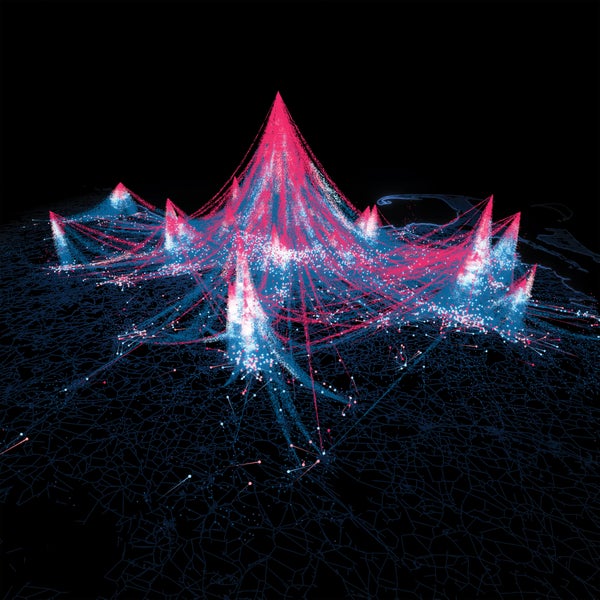The people who happen to be in a city center at any given moment may seem like a random collection of individuals. But new research featuring a simple mathematical law shows that urban travel patterns worldwide are, in fact, remarkably predictable regardless of location—an insight that could enhance models of disease spread and help to optimize city planning.
Studying anonymized cell-phone data, researchers discovered what is known as an inverse square relation between the number of people in a given urban location and the distance they traveled to get there, as well as how frequently they made the trip. It may seem intuitive that people visit nearby locations frequently and distant ones less so, but the newly discovered relation puts the concept into specific numerical terms. It accurately predicts, for instance, that the number of people coming from two kilometers away five times per week will be the same as the number coming from five kilometers twice a week. The researchers' new visitation law, and a versatile model of individuals' movements within cities based on it, was reported in Nature.
“This is a super striking, robust result,” says Laura Alessandretti, a computational social scientist at the Technical University of Denmark, who was not involved in the study but co-wrote an accompanying commentary. “We tend to think that there are lots of contextual aspects that affect the way we move, such as the transportation system, the morphology of a given place, and socioeconomic aspects. This is true to some extent, but what this shows is that there are some robust laws that apply everywhere.”
On supporting science journalism
If you're enjoying this article, consider supporting our award-winning journalism by subscribing. By purchasing a subscription you are helping to ensure the future of impactful stories about the discoveries and ideas shaping our world today.
The researchers analyzed data from about eight million people between 2006 and 2013 in six urban locations: Boston, Singapore, Lisbon and Porto in Portugal, Dakar in Senegal, and Abidjan in Ivory Coast. Previous analyses have used cell-phone data to study individuals' travel paths; this study focused instead on locations and examined how many people were visiting, from how far and how frequently. The researchers found that all the unique choices people make—from dropping kids at school to shopping or commuting—obey this inverse square law when considered in aggregate. “The result is very simple but quite startling,” says Geoffrey West, an urban scaling theorist at the Santa Fe Institute and one of the paper's senior authors.
One explanation for this strong statistical pattern is that traveling requires time and energy, and people have limited resources for it. “There is something really very fundamental at play here. Whether you live in Senegal or in Boston, you try to optimize your day,” says study lead author Markus Schläpfer of ETH Zurich's Future Cities Laboratory in Singapore. “At the core is the effort that people are willing to invest collectively to travel to certain locations.” (You can examine an interactive visualization here.)
Understanding these patterns is important not only for planning the placement of new shopping centers or public transportation but also for modeling disease transmission within cities, says Kathleen Stewart, a geographer and mobility researcher at the University of Maryland who was not involved in the study.
Many researchers estimate travel with “gravity models,” which assume that movement between cities is proportional to their population sizes. But these models do not account for travel patterns within cities—information that is particularly critical in tackling disease transmission. Northeastern University epidemiologist Sam Scarpino, who was not involved in the study, says models based on this new finding might better track that flow. For example, New York City residents are more likely to make short, frequent trips within their own borough (such as Manhattan or the Bronx) and fewer trips to a distant borough.
“Those organizational patterns have really profound implications on how COVID will spread,” Scarpino says. In a smaller rural location, where many people regularly go to the same church or grocery store, the entire town will experience sharp peaks of infections as the virus sweeps through the community. But in a bigger city, the propagation takes longer, he explains, because mini epidemics can occur in each neighborhood somewhat separately.
Stewart adds: “The authors demonstrate that their visitation law—that takes into account both travel distance and frequency of visits in a way that other models do not—outperforms gravity models when it comes to predicting flows between locations.”
